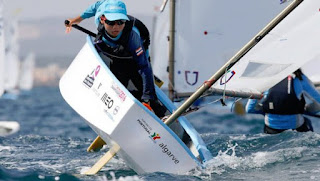Topper or Open Bic?
Topper or Open Bic? This is a question that arises today in Quebec!
This is an unexpected yet very real question, because one of the most active youth sailing clubs in Quebec, the Vaudreuil CVDM, has acquired 10 Topper dinghies, whereas it is especially the Open Bic that is the youth dinghy in vogue in North America, along with, of course, the seemingly eternal Optimist.
A friend, director of a sailing school, asked me the question: Topper or Open Bic? Here is a succinct analysis.
The most obvious difference between the two boats is that the Open Bic is a much newer design, and is part of the current trend towards skiffs, rapid sailing dinghies.
The Topper was developed in 1977 while the Open Bic was in 2006. Just a quick glance allows to see that the Open Bic is in tune with our times, while the Topper is outdated. But many outdated designs are among the most important boats in competitive sailing (Optimist, Finn, Snipe, Star, etc.), so further analysis is warranted.
In terms of sail size, both dinghies have the option to use two types of sails, including a smaller sail, allowing sailors who are particularly light (say 35 kg and over) to start in these boats without going through the Optimist.
 |
| Open Bic in Action |
The Open Bic sail is a much much more modern design, fully batten, and is made of transparent mono film. The sail is available from the manufacturer, yet there is a training version available on the market at much lower cost. (about 100 US dollars).
Both classes organize world championships. The age limit today in Open Bic is 17, while in Topper, it’s 21. Theoretically, one can therefore postpone the transition towards a dinghy such as the 420 or the Laser. Regarding Lasers, the transition from the Topper can be done directly to the Laser Radial, while for the Open Bic, it would rather be towards the Laser 4.7.
In the context of Quebec, and in Canada in general, where the temperature of the water plays an important role at the beginning of the season, the advantage is to the Topper, because sailing in the Open Bic without getting wet regularly is a little near impossible, while the Topper is more conventional as a design. (its hull looks a bit like the one of the Sunfish)
In terms of activity in North America, the advantage is clearly to the Open Bic. A quick search on the Internet did not find active Topper fleets. While there are dozens of fleets in the Open Bic, both in the US and in Canada (Ottawa for example). The Open Bic therefore offers the essential opportunity to go racing in North America, while the Topper does not really offer this opportunity.
Globally, the Open Bic has clearly the wind in its sails, in part thanks to Russel Coutts who promotes the class, including through the events of the America's Cup. The class is very present now in New Zealand, France, Spain, the United States, and a range of other countries. The Topper meanwhile remains mostly present in Ireland and the United Kingdom, but even there, it has big competition from another modern design, the RS Tera. (from the same manufacturer as the RS Aero - which was developed as a modern alternative to the Laser)
 |
| Topper in Action |
The prices of the two boats are comparable. They are cheaper than a high end race ready Optimist, and come back at about half the price of a Laser! Both types of boats seem pretty resilient and require minimal maintenance, according to the experience of clubs using these boats for their sailing schools.
In conclusion, although the Topper has a few positive aspects compared to the Open Bic, the advantage is clearly towards the Open Bic, because of its modern design and its attractiveness for young sailors in the making, and because the opportunity it offers to do regattas at the Canadian, North American and World level.
CLASS WEBSITES
VIDEOS


